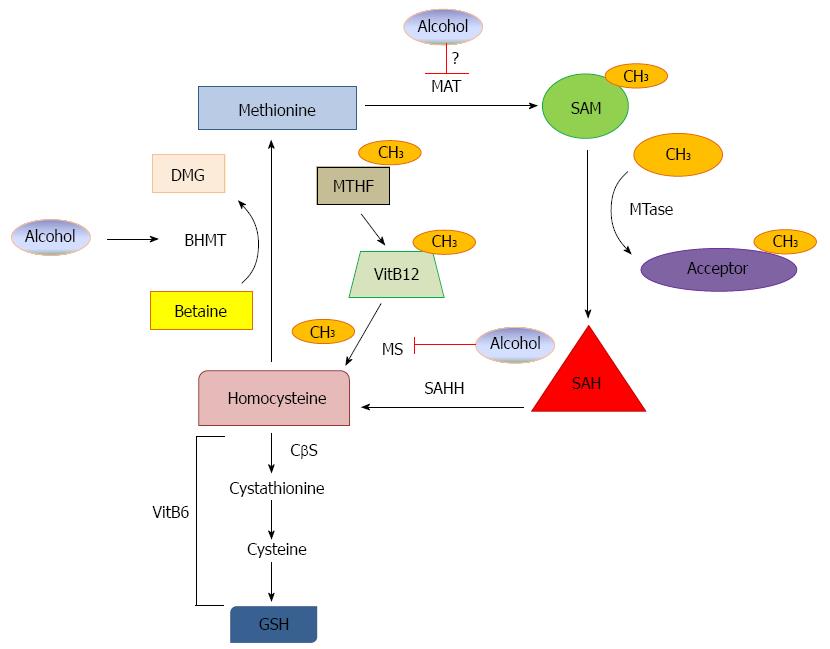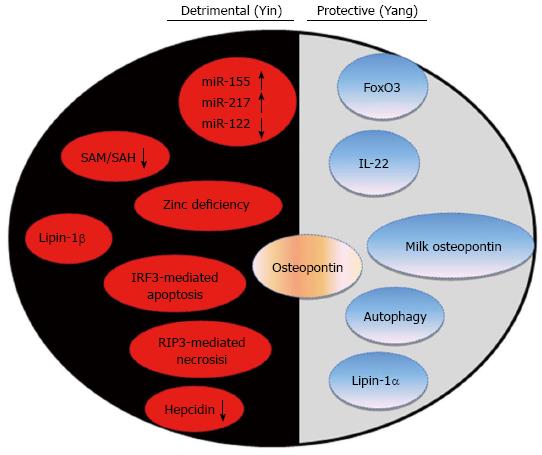Copyright
©2014 Baishideng Publishing Group Inc.
World J Gastroenterol. Sep 28, 2014; 20(36): 12908-12933
Published online Sep 28, 2014. doi: 10.3748/wjg.v20.i36.12908
Published online Sep 28, 2014. doi: 10.3748/wjg.v20.i36.12908
Figure 1 S-adenosylmethionine is produced from methionine by methionine adenosyltransferase.
After donating its methyl group, S-adenosylmethionine (SAM) is converted to S-adenosylhomocysteine (SAH), which is then converted to adenosine and homocysteine by S-adenosylhomocysteine hydrolase (SAHH). Homocysteine is used to regenerate methionine or to produce glutathione (GSH). The vitamin B6 dependent transsulfuration pathway produces GSH via reduction of homocysteine to cystathionine using cystathionine beta synthase (CβS), which can then be further metabolized to cysteine and GSH. Regeneration of methionine from homocysteine occurs by two pathways. The folate-dependent pathway regenerates methionine from homocysteine via transfer of a methyl group from N5-methyltetrahydrofolate (MTHF) to vitamin B12, which is then transferred to homocysteine by methionine synthase (MS) to form methionine. The second pathway is folate independent and uses betaine as a substrate for methionine synthesis from homocysteine via betaine homocysteine methyltransferase (BHMT). Alcohol may affect methionine metabolism via three mechanisms: alcohol inhibits MS, alcohol increases BHMT as a compensatory effect and alcohol may inhibit MAT activity, but this is still controversial.
Figure 2 Regulation of FoxO3 and its role in alcohol-induced liver injury.
Growth factors, such as insulin-like growth factor I (IGF-1), bind to their receptor and recruit insulin receptor substrate 1 (IRS-1), which further activates PI3K. Activated PI3K then converts the plasma membrane lipid phosphatidylinositol-4,5-bisphosphate (PIP2) to phosphatidylinositol-3,4,5-trisphosphate (PIP3), and PIP3 directly binds AKT to promote its activation. AKT phosphorylates FoxO3 resulting in its sequestration in the cytoplasm and interaction with 14-3-3 proteins. FoxO3 can also be ubiquitinated and degraded by the ubiquitin proteasome system, or deacetylated by SIRT1, which regulates the specificity of FoxO3 target gene expression. Dephosphorylated nuclear retained FoxO3 then binds to the promoter regions of target genes with various distinctive functions, including autophagy, DNA damage, antioxidants, cell cycle and metabolism. Acute alcohol regulates hepatic FoxO3 by inhibiting AKT, resulting in increased nuclear retention of FoxO3, which leads to increased expression of autophagy-related genes. Acute alcohol also increases acetylated levels of FoxO3, which may serve as a negative regulator of acute alcohol-induced expression of autophagy-related genes. Resveratrol activates SIRT1, which leads to FoxO3 deacetylation and enhanced expression of autophagy-related genes. Alcohol-induced activation of FoxO3 also promotes the expression of antioxidant genes. Whether alcohol affects other FoxO3-mediated target genes such as those involved in DNA damage, cell cycle and metabolism remains to be studied. Overall, alcohol-induced activation of FoxO3 protects against alcohol-induced steatosis and liver injury.
Figure 3 New progress in alcohol-induced detrimental (Yin) and adaptive protective (Yang) pathways in the liver.
Experimental and clinical research for alcoholic liver disease (ALD) in the past several years has revealed many detrimental factors leading to alcohol-induced liver pathogenesis. In addition to detrimental factors, emerging evidence indicates that alcohol consumption can also activate cellular adaptive/compensatory protective mechanisms to attenuate alcohol-induced detrimental effects. The eventual outcomes seem to be decided by the balance between the “bad” (detrimental) and “good” (adaptive protective) factors induced by alcohol in each individual person or cell. This is more like a battle between “Yin” (the dark side of detrimental) and “Yang” (the light side of protective). The emerging detrimental factors induced by alcohol are listed on the dark side and the adaptive protective factors are listed on the light side. The role of osteopontin is still controversial. Therefore approaches to inhibit the dark side (detrimental “Yin”) or boost the light side (protective “Yang”) may provide novel therapeutic tools for treating ALD.
- Citation: Williams JA, Manley S, Ding WX. New advances in molecular mechanisms and emerging therapeutic targets in alcoholic liver diseases. World J Gastroenterol 2014; 20(36): 12908-12933
- URL: https://www.wjgnet.com/1007-9327/full/v20/i36/12908.htm
- DOI: https://dx.doi.org/10.3748/wjg.v20.i36.12908











